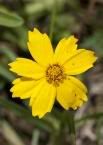

Scientific Name
Coreopsis lanceolata
Uses of Lanceleaf Tickseed: Landscaping, Medicinal, Culinary, etc...
This plant is used mainly for landscape beautification. It has potential for use in cultivated, garden situations, in naturalized prairie or meadow plantings, and along roadsides.
General Characteristics
This plant is a clump-forming perennial herb with short rhizomes. Leaves may or may not be hairy; basal leaves are divided and the upper leaves are entire and oval-shaped. The flower heads are borne singularly or in small groups on upright stems from April to June. They are 1-2 inches in diameter and yellow with a yellow center. The seed are dark brown, winged, and curved to almost semi-circular.
Required Growing Conditions
Lance-leaf coreopsis prefers full sun, but will tolerate light shade. On sites that are heavily shaded, plants produce fewer flowers and the stems grow taller. It can grow on many soil types, but prefers a well-drained soil. Natural stands are often found on dry, infertile sites.
Lance-leaf is distributed throughout the eastern and midwestern United States.
Cultivation and Care
A firm seedbed is required. Seed may be planted into a closely mowed, chemically-killed, or burned sod area with a light disking or harrowing that scratches the soil surface. When seed is sown onto a clean-tilled site, culti-packing the soil before planting is recommended. A thick layer of plant residue on the soil surface may interfere with seed germination. Broadcast or shallowly drill 5-7 grams of seed per 100 square feet (5-7 lb/acre). Planting depth should range from at the soil surface to one-eighth inch deep. Cultipacking after planting is recommended. Seed germination should occur by fall, and the plants will remain as a low-growing rosette throughout the winter.
General Upkeep and Control
Apply fertilizer according to soil test recommendations. If not available, a rate of 3.5-5.5 oz per 100 square feet (100-150 lb/acre) of 13-13-13 should be applied after the seedlings are established and annually thereafter. The initial mowing should be delayed until after seed set. Lance-leaf coreopsis can tolerate regular mowing during the summer and fall. However, if the plants are allowed to regrow after the initial mowing, they will usually flower sporadically throughout the summer. A fall mowing is recommended.
Cultivars, Improved, and Selected Materials (and area of origin) Seeds of lance-leaf coreopsis are available from commercial suppliers.





0 comments: